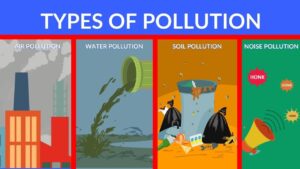Back to: Physical and Health Education JSS 2
Welcome to class!
In today’s class, we shall be talking about the meaning of environmental pollution. Please enjoy the class!
Meaning of Environmental Pollution

Pollution – the very word conjures up images of grimy smog, murky rivers, and mountains of trash. But what exactly is it? In simple terms, environmental pollution is the introduction of harmful substances into the environment. These substances, called pollutants, can be physical, chemical, or biological, and they come from a variety of sources, both natural and human-made.
Understanding the Different Types of Pollution:

Air Pollution: Smog-choked cities, the acrid smell of burning factories – these are all telltale signs of air pollution. This invisible menace includes gases like carbon dioxide and nitrogen oxides, as well as tiny particles that can lodge deep in our lungs.
Water Pollution: From industrial waste dumped into rivers to plastic choking marine life, water pollution poisons the very source of life. Chemical contaminants, excess nutrients, and pathogens all contribute to making our water unsafe for drinking and harming aquatic ecosystems.
Land Pollution: Mountains of trash, overflowing landfills, and soil contaminated with chemicals – land pollution scars the Earth’s surface. Pesticides, fertilizers, and industrial waste seep into the ground, poisoning plants and threatening food security.
Pollution isn’t just about what we can see or smell. There are more subtle, yet equally dangerous forms:
Noise Pollution: The constant din of traffic, construction, and even loud music can be incredibly disruptive, causing stress, hearing loss, and sleep problems.
Light Pollution: The artificial glow of city lights disrupts natural darkness cycles, impacting wildlife and potentially even human health.
Thermal Pollution: Power plants and factories release excess heat into water bodies, altering ecosystems and harming aquatic life.
Environmental pollution isn’t just an eyesore; it’s a threat to the health of our planet and ourselves. It can:
- Harm ecosystems: Pollution disrupts delicate ecological balances, leading to species loss, habitat destruction, and biodiversity decline.
- Contaminate food and water: Polluted air, water, and soil can find their way into our food chain, posing serious health risks.
- Contribute to climate change: Greenhouse gases like carbon dioxide trap heat, leading to rising temperatures, extreme weather events, and rising sea levels.
- Impact human health: Air pollution can cause respiratory problems, heart disease, and even cancer. Water pollution can lead to waterborne diseases and other health issues.
The good news is that we’re not powerless against pollution. As individuals and communities, we can:
- Reduce our reliance on fossil fuels: Opt for public transportation, cycling, or walking whenever possible.
- Conserve energy: Turn off lights and electronics when not in use, use energy-efficient appliances, and weatherize your home.
- Reduce, reuse, and recycle: Minimize waste, choose reusable products, and recycle diligently.
- Support sustainable businesses: Choose products with minimal environmental impact and advocate for eco-friendly policies.
By understanding the different types of pollution, their consequences, and the actions we can take, we can work towards a cleaner, healthier planet for ourselves and future generations. Remember, even small changes can make a big difference!
We have come to the end of today’s class. I hope you enjoyed the class!
In the next class, we shall be discussing the Types of environmental pollution.
In case you require further assistance or have any questions, feel free to ask in the comment section below, and trust us to respond as soon as possible. Cheers!
Question Time:
Objective Questions:
- (a) Which of the following is NOT a primary source of air pollution?
(i) Vehicles (ii) Trees (iii) Factories (iv) Power plants
(b) Explain your answer choice.
- Which pollutant can contaminate both air and water, causing respiratory problems and disrupting aquatic ecosystems?
(a) Carbon dioxide (b) Lead (c) Nitrates (d) Noise
- Which statement BEST describes the concept of “reduce, reuse, recycle”?
(a) Minimize waste, prioritize recycling, support sustainable businesses.
(b) Use alternative energy sources, plant trees, reduce water consumption.
(c) Sort trash effectively, compost food scraps, buy recycled products.
(d) All of the above.
- The Kyoto Protocol is an international agreement aimed at:
(a) Reducing deforestation (b) Protecting endangered species
(c) Controlling noise pollution (d) Mitigating climate change
- Which technological advancement offers the most promising potential for reducing land pollution from agricultural activities?
(a) Genetically modified crops (b) Precision agriculture techniques
(c) Vertical farming (d) Organic farming practices
Essay Questions:
- Define environmental pollution and discuss its major types, with specific examples relevant to your community.
- Explain the negative impact of air pollution on human health and the environment. Illustrate your answer with local or regional examples.
- Describe the role of industrial activities in water pollution and discuss strategies for minimizing their impact.
- Analyze the connection between plastic pollution and its detrimental effects on marine ecosystems. Propose solutions to address this issue.
- Compare and contrast the challenges and opportunities associated with the use of renewable energy sources in reducing greenhouse gas emissions and mitigating climate change.
